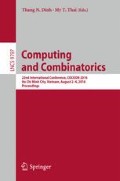Abstract
Drawing a graph in a way that minimizes the number of edge-crossings is a well-studied problem. Recently there has been work characterizing both the minimum and maximum number of edge-crossings possible in various graph classes, assuming rectilinear (straight-line) edges. In this paper, we investigate the algorithmic problem of maximizing the number of edge-crossings over all rectilinear drawings a graph. We show that this problem is NP-hard and lies in \(\exists \mathbb {R}\). We give a nontrivial derandomization of the natural randomized 1/3-approximation algorithm, which generalizes to a weighted setting as well as to an ordering constraint satisfaction problem. We evaluate these algorithms and other heuristics in simulation.
Access this chapter
Tax calculation will be finalised at checkout
Purchases are for personal use only
Notes
- 1.
For ease of exposition, we refer simply to the number of crossings for the remainder of the proof, although exactly the same analysis applies in the weighted setting, whether the weights of crossings are based on underlying edge weights or are permitted to be completely arbitrary, as in an OCSP.
References
Alon, N., Spencer, J.: The Probabilistic Method, chap. 15, pp. 249–258. Wiley, Hoboken (1992)
Alpert, M., Feder, E., Harborth, H.: The maximum of the maximum rectilinear crossing numbers of \(d\)-regular graphs of order \(n\). Electr. J. Comb. 16(1) (2009)
Bienstock, D.: Some provably hard crossing number problems. Discrete Comput. Geom. 6(5), 443–459 (1991)
Cabello, S., Mohar, B.: Adding one edge to planar graphs makes crossing number and 1-planarity hard. SIAM J. Comput. 42(5), 1803–1829 (2013)
Canny, J.: Some algebraic and geometric computations in pspace. In: Proceedings of the Twentieth Annual ACM Symposium on Theory of Computing, STOC 1988, pp. 460–467. ACM, New York (1988)
Chuzhoy, J.: An algorithm for the graph crossing number problem. CoRR, abs/1012.0255 (2010)
Erdős, P., Guy, R.K.: Crossing number problems. Am. Math. Mon. 80, 52–58 (1973)
Erdős, P., Rényi, A.: On random graphs. i. Publicationes Math. 6, 290–297 (1959)
Feder, E., Harborth, H., Herzberg, S., Klein, S.: The maximum rectilinear crossing number of the Petersen graph. Congr. Numerantium 206, 31–40 (2010)
Furry, W., Kleitman, D.: Maximal rectilinear crossings of cycles. Stud. Appl. Math. 56, 159–167 (1977)
Garey, M.R., Johnson, D.S.: Crossing number is NP-complete. SIAM J. Algebraic Discrete Methods 4(3), 312–316 (1983)
Guruswami, V., Hstad, J., Manokaran, R., Raghavendra, P., Charikar, M.: Beating the random ordering is hard: every ordering CSP is approximation resistant. SIAM J. Comput. 40(3), 878–914 (2011)
Harborth, H.: Drawing of the cycle graph. Congr. Numer. 66, 15–22 (1988)
Hlinéný, P.: Crossing number is hard for cubic graphs. J. Comb. Theory Ser. B 96(4), 455–471 (2006)
Kang, M., Pikhurko, O., Ravsky, A., Schacht, M., Verbitsky, O.: Obfuscated drawings of planar graphs. CoRR, abs/0803.0858 (2008)
Pach, J., Ábrego, B., Fernández-Merchant, S., Salazar, G.: The rectilinear crossing number of \(K_n\): closing in (or are we?). In: Pach, J. (ed.) Thirty Essays on Geometric Graph Theory, pp. 5–18. Springer, New York (2013)
Pach, J., Tóth, G.: Thirteen problems on crossing numbers. Geombinatorics 9, 194–207 (2000)
Pach, J., Tóth, G.: Which crossing number is it anyway? J. Comb. Theory, Ser. B 80(2), 225–246 (2000)
Ringel, G.: Extremal problems in the theory of graphs. In: Fiedler, M. (ed.) Theory of Graphs and Its Applications, Proceedings of Symposium Smolenice 1963, Prague, pp. 85–90 (1964)
Schaefer, M.: Complexity of some geometric and topological problems. In: Eppstein, D., Gansner, E.R. (eds.) GD 2009. LNCS, vol. 5849, pp. 334–344. Springer, Heidelberg (2010)
Schaefer, M.: The graph crossing number, its variants: a survey. Electron. J. Combin. Dyn. Surv. 21 (2014)
Turán, P.: A note of welcome. J. Graph Theory 1(1), 7–9 (1977)
Verbitsky, O.: On the obfuscation complexity of planar graphs. Theor. Comput. Sci. 396(1–3), 294–300 (2008)
Weisstein, E.W.: Star polygon (2010)
Acknowledgements
This work was supported in part by PSC-CUNY Research Award 67665-00 45, CUNY Collaborative Incentive Research Grant (CIRG 21) 2153, and a Research in the Classroom Idea Grant.
Author information
Authors and Affiliations
Corresponding author
Editor information
Editors and Affiliations
Rights and permissions
Copyright information
© 2016 Springer International Publishing Switzerland
About this paper
Cite this paper
Bald, S., Johnson, M.P., Liu, O. (2016). Approximating the Maximum Rectilinear Crossing Number. In: Dinh, T., Thai, M. (eds) Computing and Combinatorics . COCOON 2016. Lecture Notes in Computer Science(), vol 9797. Springer, Cham. https://doi.org/10.1007/978-3-319-42634-1_37
Download citation
DOI: https://doi.org/10.1007/978-3-319-42634-1_37
Published:
Publisher Name: Springer, Cham
Print ISBN: 978-3-319-42633-4
Online ISBN: 978-3-319-42634-1
eBook Packages: Computer ScienceComputer Science (R0)

